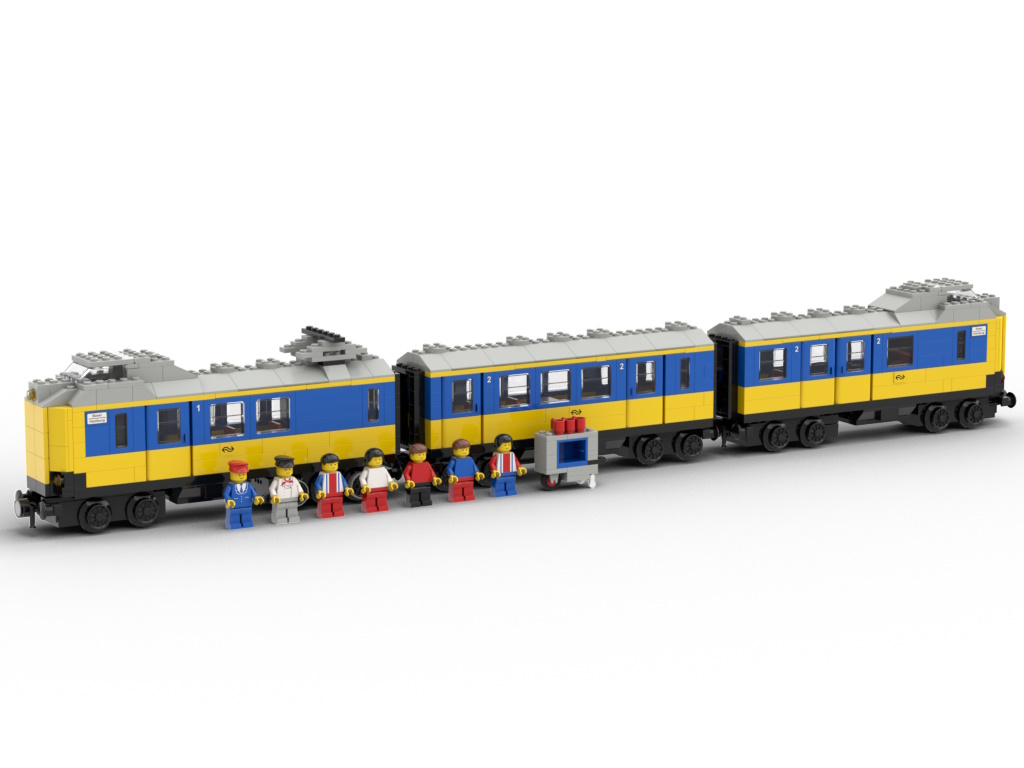
|
Intercity Train |
|
|
Instructions |
||
When designing the grey-era train sets, LEGO drew a lot of inspiration from the real-life trains around on the European railroad tracks. For the first wave of sets in 1980, LEGO specifically took a good look towards Germany. All 1980s steam engines, starting with 7750 and 7810, were modelled after the German steam engines, with their characteristic black-and-red colour scheme. The flagship 12v set 7740 was modelled after the very famous German Trans Europ Express "Rheingold", shunter locomotive 7760 celebrated the German v60. Later on, LEGO turned towards France and the Train Grande Vitesse for 7745.
With the colour scheme of 7710 closely matching the (still current) Dutch Railways (Nederlandse Spoorwegen) livery of blue-and-yellow, LEGO must at least have been aware of what was happening on the tracks in the Netherlands as well. In this series of designs, I hypothesize what LEGO could have come up with if they had taken their inspiration from the Dutch railways of the time.
In this post, I take a look at the NS class 4000 ICM 'Koploper', which could have served as a great alternative to the 12V flagship sets 7740 and 7745.
NS class 4000 ICM 'Koploper'
The NS class 4000 ICM is an electric multiple-unit train that first came into service in 1977. The ICM ('InterCity Materieel' which translates as 'Intercity Rolling Stock') was designed by the company of Raymond Loewy and features a very characteristic raised driver's compartment, allowing passengers and personnel to pass through the head of the train into the next carriage. The nickname Koploper actually translates as 'head walker'.
 |  | |
 | ||
 |  |  |
The NS ICM was revised and refurbished (and renamed to ICMm with the m standing for modernized)) between 2005 and 2010, during which the ability to open the front of the train was discontinued because of frequent failures of the system. The NS ICMm continues to be operated to this day, and most days I encounter one on my way to work as it crosses the bridge over the Amsterdam-Rhinecanal. Unfortunately, the NS ICMm is scheduled to go out of service between 2024 and 2030 after almost 50 years of service.
The LEGO version
Using the blue windows and blue-and-yellow doors of set 7710, I designed the NS ICM Koploper as a three-carriage intercity train, equal in length to passenger trains 7740 and 7745. The first and last carriage carriage are fairly symmetrical from the outside but quite different from the inside, just like 7745.
 |  | |
 | ||
 |  |  |
The first carriage contains the first-class passenger seats and the weight bricks (where the real-life train has its engine) directly underneath the pantograph. The second carriage contains second-class seats and a washing sink in the style of 7815. Having been designed for the Netherlands, the third contains a compartment for bicycles, just like the real-life version. The raised driver's compartment opens from the top in a similar way as 7745 does.
 |  | |
 | ||
 |  |  |
The most challenging part was the front and back of the train, as the nose of the train is quite round in shape. I came up with an intricate design using only 1980s pieces (thus keeping in line with the design principles of this series) but this uses studs not on top (SNOT) techniques, something LEGO certainly wasn't doing at the time.

Screenshot from Studio showcasing the light bricks and the SNOT front.
I was able to include working headlights (3 per side) using regular grey-era black light bars. Wanting to include red rearlights (again, like 7745) but also wanting to prevent cumbersome cables running from the front to the back of the train, I came up with a robust bogie design (similar in size to the 1980s motor) that uses part bb0053b from 1969 (!) to pick up the required electricity for the red rearlights.
 |  | |
 | ||
 |  |  |
The NS logo stickers are available from brickstickershop.com, the first/second class and destination stickers come from set 7710.
Comparison to 7740 and 7745
 |  | |
 | ||
 |  |  |







